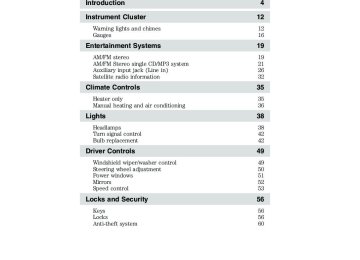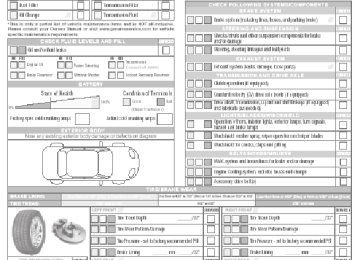- 2011 Ford Ranger Owners Manuals
- Ford Ranger Owners Manuals
- 2004 Ford Ranger Owners Manuals
- Ford Ranger Owners Manuals
- 1997 Ford Ranger Owners Manuals
- Ford Ranger Owners Manuals
- 2007 Ford Ranger Owners Manuals
- Ford Ranger Owners Manuals
- 2008 Ford Ranger Owners Manuals
- Ford Ranger Owners Manuals
- 2005 Ford Ranger Owners Manuals
- Ford Ranger Owners Manuals
- 2006 Ford Ranger Owners Manuals
- Ford Ranger Owners Manuals
- 2009 Ford Ranger Owners Manuals
- Ford Ranger Owners Manuals
- 1998 Ford Ranger Owners Manuals
- Ford Ranger Owners Manuals
- 2001 Ford Ranger Owners Manuals
- Ford Ranger Owners Manuals
- 1999 Ford Ranger Owners Manuals
- Ford Ranger Owners Manuals
- 2003 Ford Ranger Owners Manuals
- Ford Ranger Owners Manuals
- 2010 Ford Ranger Owners Manuals
- Ford Ranger Owners Manuals
- 2002 Ford Ranger Owners Manuals
- Ford Ranger Owners Manuals
- Download PDF Manual
-
High fluid level Fluid levels above the safe range may cause overheating, shift and/or engagement concerns and internal transmission damage. If an overfill condition occurs, excess fluid should be removed by an authorized dealer.
Checking and adding manual transmission fluid (if equipped) 1. Clean the filler plug. 2. Remove the filler plug and inspect the fluid level.
256
2011 Ranger (ran) Owners Guide, 2nd Printing USA (fus)
Maintenance and Specifications
3. Fluid level should be at the bottom of the opening. 4. Add enough fluid through the filler opening so that the fluid level is at the bottom of the opening. 5. Install and tighten the fill plug securely.
Use only fluid that meets Ford specifications. Refer to the Maintenance product specifications and capacities section in this chapter.
TRANSFER CASE FLUID (IF EQUIPPED) 1. Clean the filler plug. 2. Remove the filler plug and inspect the fluid level.
3. Add only enough fluid through the filler opening so that the fluid level is at the bottom of the opening.
Use only fluid that meets Ford specifications. Refer to the Maintenance product specifications and capacities section in this chapter.
257
2011 Ranger (ran) Owners Guide, 2nd Printing USA (fus)
Maintenance and Specifications
DRIVELINE UNIVERSAL JOINT AND SLIP YOKE Your vehicle is equipped with universal joints that do not require lubrication. If the original universal joints are replaced with universal joints equipped with grease fittings, periodic lubrication will be necessary.
AIR FILTER Refer to scheduled maintenance information for the appropriate intervals for changing the air filter element. When changing the air filter element, use only the air filter element listed. Refer to Motorcraftå¨ part numbers in this chapter.
WARNING: To reduce the risk of vehicle damage and/or personal burn injuries do not start your engine with the air
cleaner removed and do not remove it while the engine is running.
1. Loosen the clamp that secures the air inlet tube to the engine air filter cover and disconnect the tube from the cover (for V6 only). 2. Release the clamps that secure the air filter housing cover. 3. Carefully separate the two halves of the air filter housing.
4. Remove the air filter element from the air filter housing. 5. Wipe the air filter housing and cover clean to remove any dirt or debris and to ensure good sealing.
258
2011 Ranger (ran) Owners Guide, 2nd Printing USA (fus)
Maintenance and Specifications
6. Install a new air filter element. Be careful not to crimp the filter element edges between the air filter housing and cover. This could cause filter damage and allow unfiltered air to enter the engine if not properly seated.
7. Replace the air filter housing cover and secure the clamps. 8. Replace the air inlet tube and secure the clamp. Note: Failure to use the correct air filter element may result in severe engine damage. The customer warranty may be void for any damage to the engine if the correct air filter element is not used.
VEHICLE STORAGE If you plan on storing your vehicle for an extended period of time (30 days or more), refer to the following maintenance recommendations to ensure your vehicle stays in good operating condition. All motor vehicles and their components were engineered and tested for reliable, regular driving. Long term storage under various conditions may lead to component degradation or failure unless specific precautions are taken to preserve the components. General • Store all vehicles in a dry, ventilated place. • Protect from sunlight, if possible. • If vehicles are stored outside, they require regular maintenance to Body• Wash vehicle thoroughly to remove dirt, grease, oil, tar or mud from
protect against rust and damage.
exterior surfaces, rear-wheel housing and underside of front fenders. See the Cleaning chapter for more information. • Periodically wash vehicles stored in exposed locations. • Touch-up raw or primed metal to prevent rust. • Cover chrome and stainless steel parts with a thick coat of auto wax
to prevent discoloration. Re-wax as necessary when the vehicle is washed. See the Cleaning chapter for more information.
259
2011 Ranger (ran) Owners Guide, 2nd Printing USA (fus)
grade oil. See the Cleaning chapter for more information.
Maintenance and Specifications • Lubricate all hood, door and trunk lid hinges, and latches with a light • Cover interior trim to prevent fading. • Keep all rubber parts free from oil and solvents. Engine • The engine oil and filter should be changed prior to storage, as used • Start the engine every 15 days. Run at fast idle until it reaches normal • With your foot on the brake, shift through all the gears while the
engine oil contain contaminates that may cause engine damage.
operating temperature.
engine is running.
Fuel system • Fill the fuel tank with high-quality fuel until the first automatic shutoff
of the fuel pump nozzle.
Note: During extended periods of vehicle storage (30 days or more), fuel may deteriorate due to oxidation. Add a quality gas stabilizer product to the vehicle fuel system whenever actual or expected storage periods exceed 30 days. Follow the instructions on the additive label. The vehicle should then be operated at idle speed to circulate the additive throughout the fuel system. Cooling system • Protect against freezing temperatures. • When removing vehicle from storage, check coolant fluid level. Confirm there are no cooling system leaks, and fluid is at the recommended level.
Battery • Check and recharge as necessary. Keep connections clean. • If storing your vehicle for more than 30 days without recharging the battery, it may be advisable to disconnect the battery cables to ensure battery charge is maintained for quick starting.
Note: If battery cables are disconnected, it will be necessary to reset memory features.
260
2011 Ranger (ran) Owners Guide, 2nd Printing USA (fus)
Maintenance and Specifications
Brakes • Make sure brakes and parking brake are fully released. Tires • Maintain recommended air pressure. Miscellaneous • Make sure all linkages, cables, levers and pins under vehicle are • Move vehicles at least 25 feet (8 m) every 15 days to lubricate
covered with grease to prevent rust.
working parts and prevent corrosion.
window surfaces.
during storage (mice/squirrel nests).
Removing vehicle from storage When your vehicle is ready to come out of storage, do the following: • Wash your vehicle to remove any dirt or grease film build-up on • Check windshield wipers for any deterioration. • Check under the hood for any foreign material that may have collected • Check the exhaust for any foreign material that may have collected • Check tire pressures and set tire inflation per the Tire Label. • Check brake pedal operation. Drive the vehicle 15 ft (4.5 meters) back • Check fluid levels (including coolant, oil and gas) to make sure there • If the battery was removed, clean the battery cable ends and inspect. If you have any concerns or issues, contact your authorized dealer.
are no leaks, and fluids are at recommended levels.
and forth to remove rust build-up.
during storage.
261
2011 Ranger (ran) Owners Guide, 2nd Printing USA (fus)
Maintenance and Specifications
4.0L V6 Engine FA-1744
FG-1036
BXT-59
FL-820S2.3L I4 Engine FA-1744
FG-1036
BXT-59
FL-910SMOTORCRAFT PART NUMBERS Component Air filter element Fuel filter Battery Oil filter Spark plugs 1For spark plug replacement, see your authorized dealer. Refer to scheduled maintenance information for the appropriate intervals for changing the spark plugs. Replace the spark plugs with ones that meet Ford material and design specifications for your vehicle, such as Motorcraftå¨ or equivalent replacement parts. The customer warranty may be void for any damage to the engine if such spark plugs are not used.
262
2011 Ranger (ran) Owners Guide, 2nd Printing USA (fus)
Maintenance and Specifications
å¨
å¨
—
—
—
–
å¨
–
263
2011 Ranger (ran) Owners Guide, 2nd Printing USA (fus)
Maintenance and Specifications
å¨
å¨
å¨
å¨
å¨
å¨
å¨
264
2011 Ranger (ran) Owners Guide, 2nd Printing USA (fus)
Maintenance and Specifications
—
–
å¨

